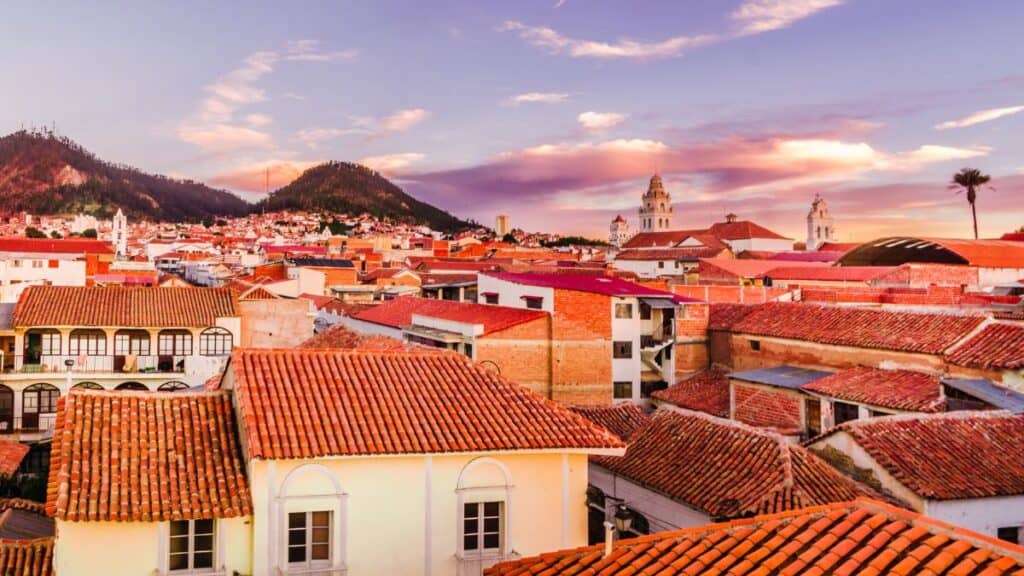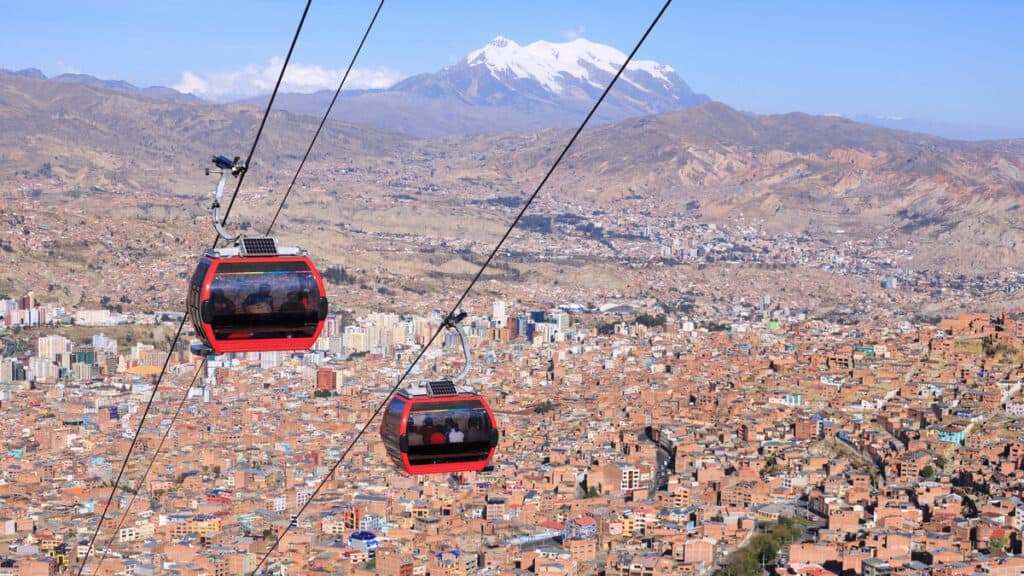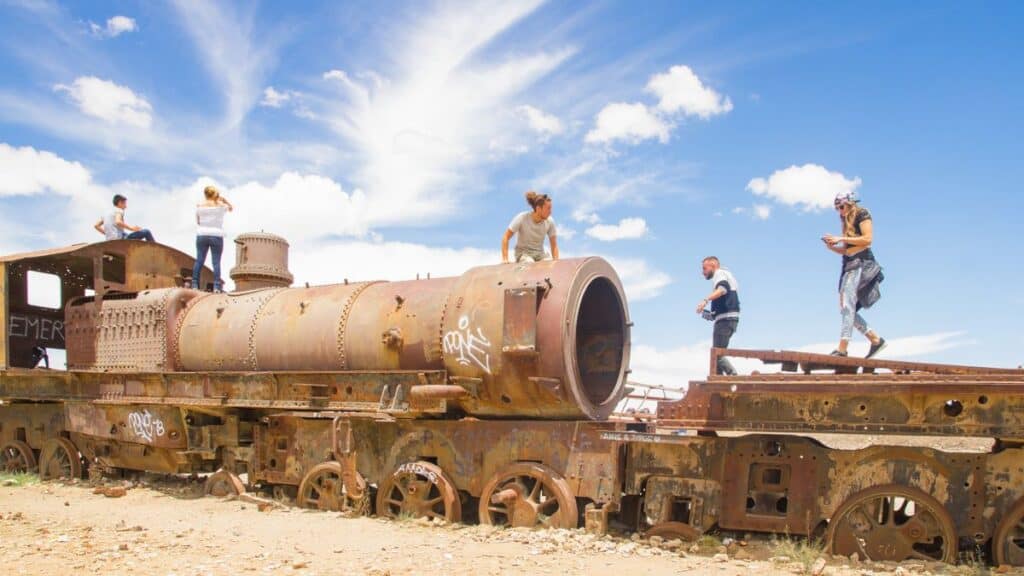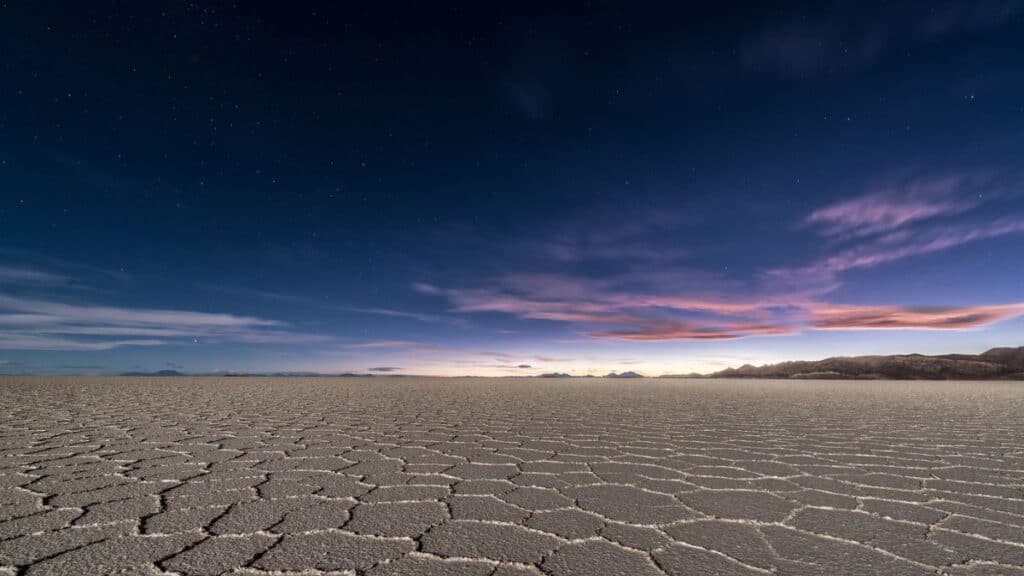Do you want to walk on the clouds or step across the blue skies? It may be a visual illusion, but the experience promises to be awesome and memorable. If you want to go on this trip, head to the Salar de Uyuni and Bolivia Salt Flats.
Salar de Uyuni is a picturesque place with one of the best views of Bolivia’s salt flats, which produce reflections you won’t see anywhere in the world. These salt flats were formed by the transformation of lakes that once covered the area.
Climate change caused the lakes to evaporate and leave layers of sediment and salt deposits. Tectonic activity and eruptions further assisted in forming a high plateau, trapping the water inside to form a magnificent salt flat.
Currently, Salar de Uyuni is the largest salt flat in the world, stretching over 4,050 square miles (10,490 square kilometers). It is located at a height of 11,995 feet (3,656 meters) close to Uyuni, Bolivia.
While a lucrative extraction site for lithium and salt, the salt flat is quite popular among tourists for its mesmerizing views.
Getting to Salar de Uyuni
From Sucre

You can get to Salar de Uyuni from many nearby cities offering great transportation options for convenient travel.
Sucre is one of the best places to start your journey. You can choose from 2 bus services (Checkmybus and Busbud), leaving at around 9 a.m. via Potosi. It takes about 8 hours to cover 224 miles (360 km), costing around 69 to 82 Bolivian bolivianos (10 to 12 US dollars).
From La Paz

La Paz offers multiple transportation options to reach the salt flats.
Here are the 2 best ways to travel:
- By Air: La Paz offers daily flights to Uyuni. Most tours to Uyuni Salt Flats start around 10 a.m., so you can get an early morning flight from La Paz to arrive on time. The best airline service in the region is Boliviana de Aviación (BoA). The airfare costs around 1,553 BOB ($225) per person (one-way)
- By Bus: Several buses leave for Uyuni at night. The total distance between La Paz and Uyuni is around 336 mi (540 km), which takes 10 to 12 hours. You can use services like Cruz del Norte, Panasur, or Trans Omar 207 to 276 BOB ($30 to $40) 1-way.
Salar de Uyuni Tours

Salar de Uyuni offers amazing tours from different starting points. Each of them offers unique experiences with different areas to explore.
Here are some of the best tours to choose from:
Complete Salt Flats Experience with a 3-Day Tour
If you want a complete experience of the salt flats and nearby popular locations, book a 3-day tour of 1,725 BOB ($250) starting from the train cemetery located around 1.9 mi (3 km away) from Uyuni. Accommodation and lunch will be covered by the tour operators.
Some of the most iconic locations, such as Avaroa National Reserve, Volcan Ollague, Isla Incahuasi, Laguna Canapa, Arbol de Piedra, Geiser Sol de la Manana, Aguas Termales de Polques, Laguna Hedionda, and Salvador Dali Desert will also be a part of your journey. Your last destination will be Laguna Negra, from where you will head back to the starting point to conclude the tour.
Full-Day Tour for the Budget Conscious

For a more budget-friendly option, a day tour to enjoy the amazing sunset and mirror effect would be ideal. You will explore the amazing salt lands and colored lagoons on a land cruiser. Snacks will be provided during your travel.
The tour will start from the Andes Expedition office at 9:30 am, costing around 345 BOB ($50) per person. It will also include a short visit to the train cemetery and Colchani, located next to the Uyuni Salt Flats. The guides help you discover all the hidden gems and take you to the best spots for pictures. The whole tour will last for about 9 hours.
See The Stars in Uyuni with a Night Tour
Many tourists love star gazing, and Salar de Uyuni doesn’t disappoint. A night tour of this place will allow you to experience the amazing view of the Milky Way and the night sky. The tour starts at 3 a.m. from a hotel in Uyuni, costing around 1,373 BOB ($199) per person. A 4×4 will pick you up from the hotel and take you to the location.
Once there, you will instantly notice the stunning view of stars reflecting from the salt flat’s surface. You will stay there for 5 hours and return after experiencing sunrise. For the best experience, opt for this option during the dry season.
Best Time to Go on a Salar de Uyuni Tour
Salar de Uyuni is one of the few places that offer a memorable experience regardless of the time you visit. However, if you have any photo requirements, here are some key weather information to help you time your visit with your desired weather.

First, Bolivia has 2 seasons throughout the year: dry and wet. The cold and dry season starts in May and ends in October. This is the best time to go if you want brighter days and clearer skies at night, adding extra vibrancy to your photos.
The wet season lasts from November to April. It has an average daily temperature of 66°F (19°C), with January being the hottest month with an average daily high of 68°F (20°C). On the other hand, the dry season is much colder, with an average daily temperature below 56°F (13°C).
For the best pictures, we suggest you visit in February when the rainwater covers the whole land, which produces a perfect reflection of the sky. The reflection is also known as the mirror effect.
However, for such an experience, you will have to give up on driving on these lands and go on a tour – since the water makes driving quite dangerous.
Where To Stay on a Salar de Uyuni Salt Flats Tour
The best place to stay on your visit to the Salar de Uyuni Salt Flats tour is in Uyuni itself. Although it is a small city, Uyuni has numerous hotels and hostels offering comfort at affordable prices.
3 of the best accommodation in the city are as follows:
Budget: Piedra Blanca Backpackers Hostel
As the name suggests, the Piedra Blanca Backpackers Hostel is an ideal place for backpackers looking for a long stay. The hostel is only 1.9 mi (3 km) away from the airport.
You can get free Wi-Fi, free parking, and a delicious daily a la carte breakfast.
Mid-range: Tonito Hotel
Tonito Hotel is a mid-range option for those who want to enjoy luxury at an affordable price. The hotel offers amenities like a private bathroom, television, and a yummy complimentary breakfast. You can also get laundry service for a small fee.
The main highlight of staying here is the delicious pizza at an on-site restaurant called Minuteman.
Luxury: Casa de Sal
Casa de Sal is in the city’s center. The hotel offers a luxurious experience with free Wi-Fi, private parking, an on-site restaurant, an airport shuttle, family rooms, a dining table, a seating area, heating, a private bathroom, flat screen TV, and more.
For more accommodation options, you may click on the map.
Important Tips When Going on a Salt Flats Tour

Here are 7 expert tips to get the most out of your Salt Flats tour in Bolivia:
- Always have a guide to help you get to the hidden locations near the salt flats.
- Some essential things to pack include sunscreen, warm clothes, a sleeping bag, a rain jacket (during the wet season), a camera, water bottles, swimsuits (for the nearby hot springs), and hiking boots. Do not forget your sunglasses, as, without them, the reflection of the salt will severely affect your experience.
- You will spend most of the time admiring the beauty of the place from a 4×4, so make sure to sit in front if you get car sick easily.
- Get yourself acclimatized to the altitude properly before heading to the salt flats.
- December and January receive a lot of rain, causing tour cancellations, so check the weather forecast before booking.
- Salar de Uyuni is a fragile ecosystem susceptible to human activity. Make sure to respect the environment and follow the site rules.
- Keep your camera close to the ground for the best pictures.
How To Stay Safe During Your Visit In Salar de Uyuni and Bolivia Salt Flats?
During your visit to the Salar de Uyuni Salt Flats in Bolivia, it’s important to prioritize safety by ensuring you travel with a reputable tour operator, as the vast, featureless landscape can be disorienting. Also, stay hydrated and prepared for altitude sickness, as the flats are located at a high elevation.
Additionally, consider protecting yourself with travel insurance such as SafetyWing, which can cover medical emergencies, trip cancellations, and other unforeseen incidents during your stay. Use the widget below to snag the perfect policy for your needs and travel with peace of mind knowing you’ve got your back covered, no matter what adventures come your way!
Frequently Asked Questions (FAQs) – Salar de Uyuni and Bolivia Salt Flats
What Is Special About the Uyuni Salt Flats?
The Uyuni Salt Flats in Bolivia are the largest salt flat in the world.
However, its main highlight is the mirror effect, a perfect reflection of the sky on 4,050 sq. mi (10,489.45 sq. km) of land. This phenomenon attracts many tourists from all over the world to get stunning photographs.
How Much Does It Cost To Go to Uyuni Salt Flats?
The cheapest day tour would cost around 345 BOB ($50); however, more expensive options include 3-day tours costing between 1,380 to 2,071 BOB ($200 to $300).
Where Are the Salar de Uyuni Salt Flats Bolivia?
The Salar de Uyuni Salt Flats are located in the country’s southwestern part. It lies in the province of Daniel Campos, around 11,995 ft (3,656 m) above sea level on the Altiplano of Bolivia.
What Should I Wear to the Salt Flats?
The weather in Uyuni is pretty cold. If you are visiting during the dry season, we highly recommend packing warm clothes since temperatures can go below 32°F (0°C).
Don’t forget to bring a rain jacket for the summer or the wet season.
Conclusion – Salar de Uyuni and Bolivia Salt Flats
Salar de Uyuni, the world’s largest salt flat in Bolivia, is a mesmerizing natural wonder that transports you to a different world. With its vast expanse of glistening white salt, mirror-like reflections, and vibrant surroundings, it offers an enchanting and unforgettable experience.
Explore this surreal landscape, interact with friendly locals, and capture breathtaking photographs. Let the Bolivia Salt Flats ignite your sense of wonder and create memories that will last a lifetime.
Your Ultimate Travel Guide & Booking Resources
Skyscanner is my trusted ally for booking flights, guiding me to the perfect travel options while making the journey planning process a breeze with its user-friendly interface and extensive search capabilities.
12Go Asia is my ultimate travel companion in Asia, offering the best budget service platform for seamless booking of trains, buses, ferries, and flights, ensuring every adventure unfolds smoothly and effortlessly.
Booking.com is my ultimate lodging partner. It offers many accommodations worldwide and simplifies my travel experiences with its user-friendly platform and unbeatable deals.
Get Your Guide is my go-to for personalized travel experiences, enriching my journeys with unique tours and activities curated to my interests, making every adventure unforgettable and tailored to my preferences.
SafetyWing is my peace of mind on the go, offering comprehensive travel medical insurance with affordable plans and hassle-free claims, ensuring I can explore the world worry-free, knowing I’m protected wherever I roam.
LifeStraw Go Bottle is my trusted hydration companion for outdoor adventures, filtering water on-the-go to keep me safe and hydrated, ensuring every hike or travel experience is worry-free and enjoyable.
Related reads:
- 13 Unique Things to Do in La Paz Bolivia on Your Next Vacation
- Bolivia’s Best Kept Secrets: A Guide to the Most Amazing Things To Do in Bolivia
Founder of Spark Nomad, Radical FIRE, Copywriter
Expertise: Personal finance and travel content. I’m a full-time traveler, and I’ve been to 49 countries and 5 continents.
Education: Bachelor of Economics at Radboud University, Master in Finance at Radboud University, Minor in Economics at Chapman University.
Over 200 articles, essays, and short stories published across the web.
Marjolein Dilven is a journalist and founder of Spark Nomad, a travel platform, and Radical FIRE, a personal finance platform. Marjolein has a finance and economics background with a master’s in Finance. She has quit her job to travel the world, documenting her travels on Spark Nomad to help people plan their travels. Marjolein Dilven has written for publications like MSN, Associated Press, CNBC, Town News syndicate, and more.

